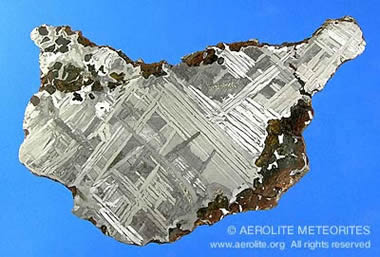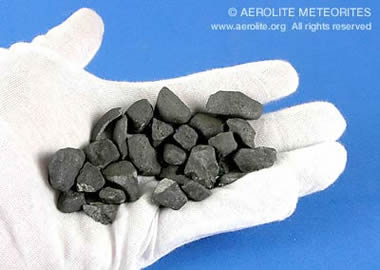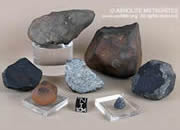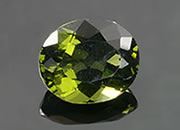Home » Meteorites » What Are Meteorites?
 Illustration by Timothy Arbon
Illustration by Timothy Arbon
WHAT ARE METEORITES?
The first in a series of articles by Geoffrey Notkin, Aerolite Meteorites

Sikhote-Alin Iron Meteorite: A fine example of a Sikhote-Alin iron meteorite, weighing 409.9 grams, which was seen to fall in eastern Russia in February of 1947. This meteorite is described as an individual, as it is a complete mass (rather than an exploded shrapnel fragment) which fell to earth on its own. Note the abundant overlapping regmaglypts (thumbprints) caused by surface melting as the meteorite flew through our atmosphere. Regmaglypts are one of the key surface features used to identify meteorites. Sikhote-Alin is a coarsest octahedrite iron in the group IIB, and is comprised of approximately 93% iron, 6% nickel and 1% trace elements. Photo copyright Aerolite Meteorites / Geoffrey Notkin. Click to enlarge.
Welcome!
Welcome to the first edition of Meteorwritings.
I am a science writer, photographer, and professional meteorite hunter. I travel the world looking for actual rocks from outer space, and I write about my adventures for both scientific and popular magazines. I have also made documentaries about meteorite hunting for PBS, National Geographic, The History Channel, and the Travel Channel. I was thrilled by the invitation to contribute to Dr. King's Geology.com and in the months ahead I will discuss the origins of meteorites, what they are made of, why they are valuable to science and collectors, and even how to find and identify them. I hope to share my enthusiasm for these amazing visitors from deep space.
Our long-time friend Geoffrey Notkin was kind enough to prepare this video, explaining how the Meteorwritings article series came about and the relationship between Geology.com and Aerolite Meteorites. We greatly appreciate the work that Geoff and his staff put into writing the articles, taking the photos, and creating the banner that you see at the top of this page. It is an honor to have the writings of one of the world's most prominent meteorite experts on Geology.com.

Canyon Diablo Iron Meteorite: A 1,179-gram specimen of the Canyon Diablo iron meteorite, found at the famous impact site, Meteor Crater, near Winslow, Arizona. The crater is erroneously named - craters are formed by meteorites, not meteors - but it is spectacular nonetheless: the best preserved impact crater in the world and something of a mecca for meteorite enthusiasts. Unfortunately meteorite hunting is not allowed at the privately owned site, but specimens of this historic meteorite are sometimes available from old collectors and prospectors who hunted at the site decades ago. This specimen is a twisted fragment - its interesting shape a result of the tremendous impact and explosion which made the crater. Such pieces are described as "sculptural" because of their attractive, aesthetic shapes, and are highly sought after by meteorite collectors. The impact is believed to have occurred approximately 25,000 years ago, and this specimen is in as-found condition and displays an orange/ochre patina, caused by long term weathering and oxidation in a desert environment. Photo copyright Aerolite Meteorites / Geoffrey Notkin. Click to enlarge.
What are Meteors?
Every year hundreds of hopeful people contact me because they believe that an unusual or out-of-place rock they have found is a meteorite. I frequently receive emails which contain an amusing but impossible statement along the lines of: "I think I've found a meteor."
In order to appreciate the humor inherent in this sentence we must first understand the difference between meteors and meteorites. Meteor is the scientific name for a shooting star: the light emitted as fragments—usually rather small—of cosmic material which we sometimes see at night, burning high up in the earth's atmosphere. The bright, and typically very short-lived flame, is caused by atmospheric pressure and friction as pieces of extraterrestrial material become so hot they literally incandesce, as does the air around them. Manned spacecraft such as NASA's space shuttle and the Mercury, Gemini, and Apollo capsules experienced similar heating during re-entry into our atmosphere, which is why they employ heat shields to protect the astronauts and cargoes inside.
Meteor Showers
There are a number of periodic meteor showers visible each year in the night sky: the Perseids in August, and the Leonids in November usually being the most interesting to observe. The annual meteor showers are the result of our planet passing through debris trails left by comets. The meteors we see during those annual displays are typically small pieces of ice which rapidly burn up in the atmosphere and never make it to the surface of our planet.

Seymchan iron meteorite: The Seymchan meteorite was originally discovered near Magadan in Russia in 1967 and was classified as an IIE iron. Recently, colleagues of mine mounted a new expedition and returned to the original find site, where they were happily surprised to discover pallasites (attractive stony-iron meteorites containing olivine crystals) in the same zone, making Seymchan similar to the Glorieta Mountain (New Mexico) and Brenham (Kansas) meteorite, both of which have produced examples of pallasites and siderites (irons) from the same fall. Although the pallasite and siderite specimens are somewhat different in composition, they did originate within the same mass, which likely exploded high up in the atmosphere. This complete slice is an extremely rare and interesting transitional specimen which shows characteristics of both pallasites (olivine crystals) and irons within the same specimen. This slice has been polished and then etched with a mild solution of nitric acid to reveal its beautiful interior crystalline structure known as a Widmanstatten Pattern. Picture copyright Aerolite Meteorites / Geoffrey Notkin. Click to enlarge.
Sporadic Meteors
A sporadic is a meteor which is not associated with one of the periodic showers and the majority of those meteors also burn up entirely in the atmosphere which acts as a shield, protecting us earthbound humans from falling space debris. Any portion of a meteor which does survive its fiery flight and falls to the surface of the earth is called a meteorite. So, meteorite scientists and hunters understandably chuckle to themselves when a hopeful person claims to have discovered a meteor. The excited people who ask me to help them identify a strange rock should actually be saying: "I think I've found a meteorite."
A polite and charming lady once telephoned the Aerolite Meteorites office and asked if we had, for sale, any meteorites from the constellation of Castor and Pollux. I explained to her that most—or possibly all—meteorites found on earth originate from within the Asteroid Belt between Mars and Jupiter, but there is a chance that some meteorites come to us from farther afield.
It has been theorized that rare carbon-bearing meteorites known as a carbonaceous chondrites—such as Murchison which fell in Victoria, Australia in 1969—may be the remnants of a comet nucleus, but that remains conjecture. The stone meteorite Zag, which was seen to fall in the Western Sahara in 1998 and later recovered by nomads, contains water and so a slightly more fanciful but intriguing theory developed which suggests that large meteorites may have carried both water and amino acids (the so-called "building blocks of life") to our planet in the distant past.

Small stone meteorites: A handful of small, freshly fallen stone meteorites which landed in the Republic of Mali in Northwest Africa during the fall of 2007, making them one of the newest extraterrestrial arrivals on earth. Meteorites are typically named after the nearest town or geological feature to the point of impact, and although this meteorite was originally and unofficially known as Mali, it will likely be renamed Erg Chech, once official classification has been approved by academia. These stones were picked up immediately after their fall and display a rich, black fusion crust. Picture copyright Aerolite Meteorites / Geoffrey Notkin. Click to enlarge.
What are Meteorites?
Meteorites are rocks, usually containing a great deal of extraterrestrial iron, which were once part of planets or large asteroids. These celestial bodies broke up, or perhaps never fully formed, millions or even billions of years ago. Fragments from these long-dead alien worlds wandered in the coldness of space for great periods of time before crossing paths with our own planet. Their tremendous terminal velocity, which can result in an encounter with our atmosphere at a staggering 17,000 miles per hour, produces a short fiery life as a meteor.
Most meteors burn for only a few seconds, and that brief period of heat is part of what makes meteorites so very unique and fascinating. Fierce temperatures cause surfaces to literally melt and flow, creating remarkable features which are entirely unique to meteorites, such as regmaglypts ("thumbprints"), fusion crust, orientation, contraction cracks, and rollover lips. These colorful terms will be discussed and examined in future editions of Meteorwritings.

Carbonaceous Chondrite: A complete slice of a rare carbonaceous chondrite found in the Sahara Desert. This stone meteorite has been cut and polished to reveal an abundance of brightly colored and densely packed chondrules. These grain-sized inclusions are believed to have formed in the solar nebular more than 4.6 billion years ago, and therefore pre-date the formation of our own planet. While chondrites are the most abundant type of meteorite, it is very unusual to find specimens which contain such a wealth of distinct chondrules. Photograph copyright Aerolite Meteorites / Geoffrey Notkin. Click to enlarge.
Meteorites: Very Rare and Very Old
Meteorites are among the rarest materials found on earth and are also the oldest things any human has ever touched. Chondrules—small, colorful, grain-like spheres about the size of a pin head—are found in the most common type of stone meteorite, and give that class its name: the chondrites. Chondrules are believed to have formed in the solar nebula disk, even before the planets which now inhabit our solar system.
Our own planet was probably once made up of chondritic material, but geologic processes have obliterated all traces of the ancient chondrules. The only way we can study these 4.6 billion year old mementoes from the early days of the Solar System is by looking at meteorites. And so meteorites become valuable to scientists as they are nothing less than history, chemistry, and geology lessons from space.
| Meteorwritings Menu |

Meteoroid shower: An artist's impression of meteoroids (potential meteorites) about to enter the earth's atmosphere. Most meteorites which land on our planet are believed to have originated within the Asteroid Belt. Click to enlarge. Image copyright iStockphoto / duuuna.
Gemstones from Space
Some meteorites even contain gemstones. The beautiful Brenham pallasite, found in Kiowa County, Kansas is packed with sea-green olivine crystals, which is also known as the semi-precious gemstone peridot. Both the Allende meteorite which fell in Chihuahua, Mexico, and the Canyon Diablo iron which formed Arizona's immense and erroneously named Meteor Crater (craters are formed by large meteorites, not meteors) contain micro diamonds.
The rarity of meteorites, along with the fact that they are the only way in which most of us will ever have the chance to touch a piece of an alien world, make them of great interest to an ever-expanding network of private meteorite collectors. Meteorite collecting is an exciting and growing hobby and there are perhaps a thousand active enthusiasts in the world today. The international space rock market is something else we will explore in the months ahead.
Geoff Notkin's Meteorite Book
|
About the Author
|
Geoffrey Notkin is a meteorite hunter, science writer, photographer, and musician. He was born in New York City, raised in London, England, and now makes his home in the Sonoran Desert in Arizona. A frequent contributor to science and art magazines, his work has appeared in Reader's Digest, The Village Voice, Wired, Meteorite, Seed, Sky & Telescope, Rock & Gem, Lapidary Journal, Geotimes, New York Press, and numerous other national and international publications. He works regularly in television and has made documentaries for The Discovery Channel, BBC, PBS, History Channel, National Geographic, A&E, and the Travel Channel.
Aerolite Meteorites - WE DIG SPACE ROCKS™
| More Meteorites |
 |
What Are Meteorites? |
 |
Extraterrestrial Gems |
 |
Gifts That Rock |
 |
Collecting Meteorites |
 |
Moldavite |
 |
The Vredefort Crater |
 |
Mars Meteorites |
 |
Meteorite Identification |

Find Other Topics on Geology.com:

|

| ||

|

| ||

|

| ||

|

|


